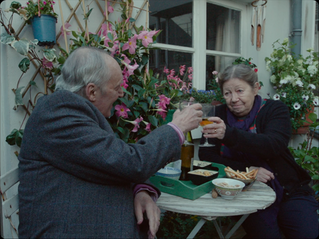Laura
- Kirby Moore
- Feb 17, 2022
- 2 min read
Otto Preminger, 1944

I find that the best films can be defined by a particular frame—one you can still remember vividly much later. Maybe for its beauty, maybe for its sadness, almost certainly for the feeling it evokes. A moment where, however briefly, the entire spirit of a story is flawlessly captured in a single shot. Laura, 1944 is one such film.
The particular shot to which I refer, wherein Det. Lt. McPherson studies a painting of the titular Laura Hunt, serves to encapsulate an entire cinematic genre. In fact, it plays on the viewer’s recognition of such: a recognition made possible not through one's aesthetic or technical understanding of cinema, but by identifying the specificities of Old Hollywood film noir.
Indeed, the shot’s identification with the noir genre is unmistakable. The chiaroscuro creates drama and suspense; harsh shadows, thrown by the candelabra and the painting’s ornate frame, bleed across the wall. You can almost hear the transatlantic drawl of the speakers and the breathtakingly evocative score. The result is an amalgamation of noir themes: cynicism, desperation, love, infatuation. This shot is, perhaps, at the same time, the epitome of 1940’s crime fiction and of the iconic Golden Age noir.
Of all the genre markers in this shot, I consider the presence of McPherson to be the most emblematic. It is his costuming, undoubtedly, that makes him so quintessentially noir: the fedora pulled low over his eyes, the wide-shouldered trench coat flipped up at the collar. There is no room for misinterpretation — this is the mandatory wardrobe of any noir detective.
The focal point is, of course, Laura. Laura is beautiful. She has the sultry elegance of the classic femme fatale but seemingly without the deceit and double-crossing. She looks out from her frame as she has done the entire film. This repetition establishes the portrait as a character in itself. She watches other characters as they argue; she watches as they lie; she watches as they make accusations, fake alibis and drink cheap scotch. Her portrait, though it fails to capture her warmth, her vibrance, perfectly expresses her grace and the mythic quality that shrouds her. It illustrates Laura as the embodiment of youth, beauty, innocence and mortality. This disparity, between Laura’s liveliness as depicted in the painting and the immortality and timelessness of the painting itself, serves as a constant reminder of Laura’s own illegibility.
As McPherson gazes up at Laura, she, in her endless elegance, stares serenely out of her frame, and we watch as the detective falls in love with a likeness, a representation, a painting. For a genre so markedly reliant upon signifiers and symbols, the representational symbol of Laura, rather than Laura herself, is a suitable summary of the doubleness of film noir, of the slippage between appearances and reality.
‘I will never forget the weekend Laura died'. While these words mark the viewer's entry into the narrative, they relate, too, to the experience of watching the film itself. Indeed, as a consequence of its exquisite cinematography Laura, as a film, is certainly difficult to forget.








Comments